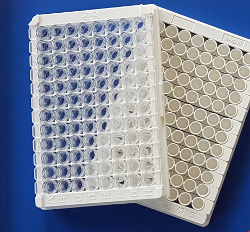Covalent binding surfaces for Immunoassays
PolyAn´s reactive microplates are beneficial for immobilizing biomolecules that inefficiently coat by passive adsorption. PolyAn offers amine-binding and nucleophilic binding surfaces as well as 3D-Azide plates for bio-orthogonal binding via click-chemistry.
Key features
- Reactive surfaces for covalent immobilization ensure minimal leaching
- Withstands rigorous washing
- Minimal unspecific binding due to 3D functional matrix
- Control of orientation of the probe to be immobilized and even directed (bio-orthogonal) immobilization possible

Products
3D-Azide 96 well plate ELISA, C-bottom, transparent, 12 x 8 strip, 100 µL functionalisation volume
| Id | 00 695 601 |
| Title | 3D-Azide 96 well plate ELISA, C-bottom, transparent, 12 x 8 strip, 100 µL functionalisation volume |
| Substrate | PS plate |
| Format | 96 well plate ELISA, C-bottom, transparent, 12 x 8 strip |
| Mean Diameter | |
| Color Labeling | |
| Surface Modifications | 3D-Azide |
| Solids Content | |
| Product Dimensions | 85 x 128 x 14 mm |
| Packaging | |
| Packaging Volume | 4 Plates/Box |
| Package Weight | 158 g |
| Dimensions | 128 x 86 x 45 mm |
| Hts Code | 39 26 90 97 |
| Pads Wells | 96 |
| Pad Size | |
| Well Format | C-bottom |
| Product Thickness | |
| Description | 3D-Azide functionalized plates for covalent coupling of Alkyne- or DBCO- modified biochemical species via click-chemistry. |
| Image |
The plates are offered for colorimetric, chemiluminescence and fluorescent detection systems, respectively. Please go to this section for glass bottom plates with a wide range of surfaces and well designs. Additionally, PolyAn offers functionalized, solvent stable microplates that are comprised of Polypropylene (PP) as well as covalently coated Streptavidin and Neutravidin plates.
Customized plate surfaces
Please do not hesitate to contact us, if you require a special surface for binding of your biomolecules that is not listed in the products table. Other plate formats and substrates can be equipped with our surfaces as part of our Molecular Surface Engineering Services. We are also happy to support you in developing suitable protocols for coating on our plates.
